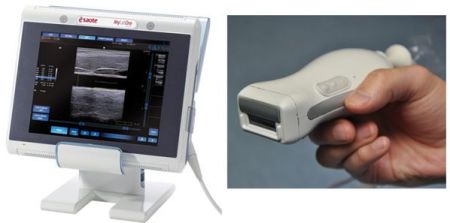A team of university and industry researchers in the Netherlands and France have developed a new handheld probe that offers powerful new imaging capabilities to doctors. The device has been discussed in a recent paper published in The Optical Society's (OSA) open-access journal Optics Express.
The project is the result of collaboration between the University of Twente and three European companies: ESAOTE Europe, a maker of medical diagnostic systems; Quantel, a maker of solid state lasers; and SILIOS Technologies, a maker of optical components.
The handheld probe combines two imaging modalities: ultrasound and photoacoustics. While ultrasound is a widely used imaging technique, photoacoustics is still relatively new, and is slowly making its way toward widespread clinical application. One important advantage of the photoacoustic technique is that it reveals important medical information that other imaging techniques cannot. This includes the presence of molecules like haemoglobin and melanin and the sub-millimetre structure of networks of blood vessels several centimetres beneath the skin. In addition, photacoustics, when combined with spectroscopic measurements, can quantify haemoglobin oxygen saturation within single vessels thus providing important metabolic information.
However, despite these benefits, photoacoustic systems are not used widely because of cost and size limitations. These are the type of hindering factors that the research team is trying to overcome with this new development.
The team has designed an ultra-compact laser based on an efficient and inexpensive laser diode. Multiple diodes were stacked to increase the power. The device has carefully designed optical elements in the shape of a laser beam that generates pulses with energies that are higher than ever achieved before with the diode technology.
Khalid Daoudi, a researcher in the Biomedical Photonic Imaging Group at the University of Twente in the Netherlands points out that diode lasers can provide many laser pulses per second, which allow real time imaging, a major advantage of the new system. Another advantage is that the new compact imaging system can be transported easily between rooms in a clinical setting.
The device has been tested in different types of phantoms and in a healthy human finger joint. The research team is currently working with a European consortium of industrial and academic partners so that they can take this new innovation to the commercialisation phase.
Currently, the system operates at a single wavelength in the near infrared but the team plans to further expand the design to multi-wavelength imaging. Some of the key targeted applications include burn wounds, cardiovascular disease, oncology and rheumatoid arthritis in finger joints.
Source: The Optical Society
Image Credit: Pim van den Berg/Khalid Daoudi



























